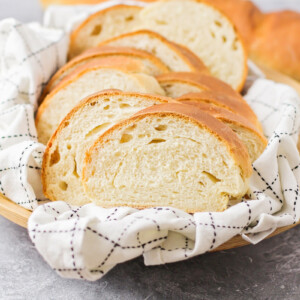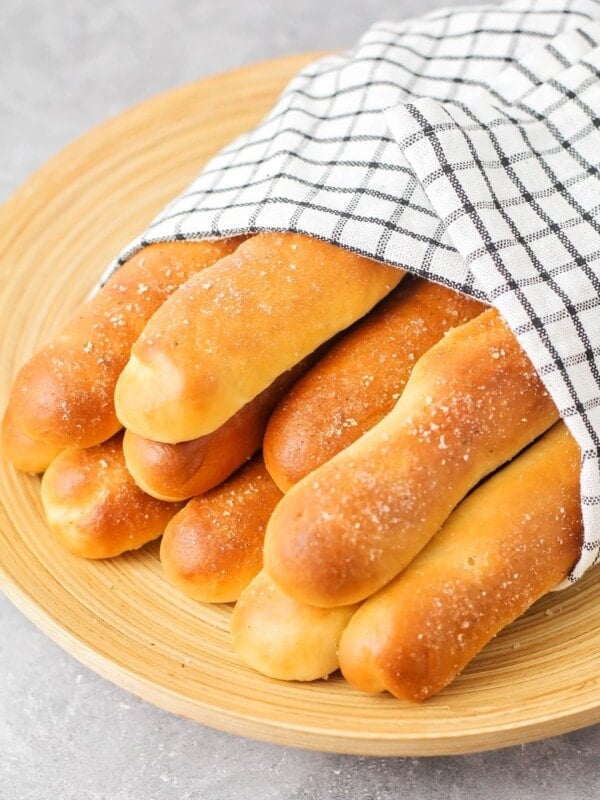This post may contain affiliate links. Please read our disclosure policy.
It is so easy to make our Italian bread recipe at home! This soft, crust bread is delicious and takes just 6 simple ingredients.

A Simple Yeast Bread
Making homemade bread really isn’t difficult, especially making simple loaves like this Italian bread recipe.
For this recipe, you don’t even need to pull out a mixer; all you need is a large mixing bowl! Plus, this Italian bread recipe only requires SIX ingredients that you likely already have on hand. The finished product is not just one, but TWO yummy loaves!
We love to serve it with our favorite pasta dishes (like Spaghetti and Fettuccine Alfredo) or a fresh salad. We’ve even added garlic butter and toasted it for a bit of crust and extra flavor (there are never leftovers)!
So don’t let the yeast intimidate you. Of all the yeast breads you could try to master, this one is one of the simplest!
WHY WE LOVE IT:
- Pantry staples. The ingredients are simple and most likely already in your pantry!
- Easy steps. Working with yeast is simple – and we’ll “proof” it! 😉
- Makes two loaves! Your effort will be rewarded with two delicious loaves of crusty Italian bread. YUM!

Ingredients
PREP TIME: 40 minutes
RISE TIME: 1 hour 30 minutes
COOK TIME: 30 minutes
- 2 cups very warm water – between 105°F and 115°F
- 5 teaspoons instant yeast or rapid rise – If you use active dry yeast, you will need to bloom it in warm water before adding in other ingredients. see How to Activate Yeast
- 1 tablespoon sugar
- 2 tablespoons vegetable oil – canola oil, or olive oil
- 1 tablespoon salt
- 5 cups all purpose flour – or bread flour for chewier crumb
- optional – butter to brush on top of baked loaves






How to Make Italian Bread
- DOUGH. Whisk 2 cups warm water, 5 tablespoons instant yeast, 1 tablespoon sugar, 2 tablespoons oil, and 2 cups of flour in a large bowl till smooth. Let sit in a warm place till bubbly, about 30 minutes.
- Add 1 tablespoon salt and 1½ cups flour and mix. Continue mixing in flour until no longer sticky and a soft dough is formed.
- RISE. Knead for a couple of minutes on a lightly floured surface till smooth. Return to bowl. Cover and let rise till doubled, about an hour.
- Placing the dough near a warm window, crock pot, or oven can help it rise faster.
- When it looks like it has doubled in size poke it with your finger. If the dough springs back and fills in the dent, let it rise longer. If the dent stays, it’s ready.
- SHAPE. Divide the dough in half and roll each piece into a long loaf about 12 inches long. Place both loaves on a greased baking pan.
- 2ND RISE. Cover with a tea towel and let loaves rise till doubled (about 30-45 minutes). Score using a sharp blade or scissors to make 3-4 shallow (¼ to ½ inch) slits on the top of the dough before baking. This allows air to escape without cracking the bread.
- BAKE. Bake in an oven preheated to 375°F for about 30 minutes or until the crust is golden brown. Let the loaves cool on wire racks. Serve this Italian bread recipe warm on its own or with your favorite pastas and lasagnas.

Complete The Meal
Main Dish
Kid-Friendly Spaghetti
50 mins
Fettuccine Alfredo Recipe
35 mins
Italian Sausage Pasta
20 mins
Olive Garden Zuppa Toscana
35 mins
More Bread
Homemade French Bread
1 hr 15 mins
Focaccia Bread
8 hrs 55 mins
Sourdough Bread
8 hrs 40 mins
Olive Garden Breadsticks
2 hrs 27 mins
Collections

Italian Bread Recipe
Ingredients
- 2 cups very warm water
- 5 teaspoon instant yeast
- 1 tablespoon sugar
- 2 tablespoons vegetable oil
- 1 tablespoon salt
- 5 cups all purpose flour
Instructions
- Whisk water, yeast, sugar, oil, and 2 cups of flour in a large bowl till smooth. Let sit in a warm place till bubbly, about 30 minutes. Add the salt and add enough flour to make a soft dough.
- Knead a few times on a floured counter till smooth. Return to bowl. Cover and let rise till doubled, about an hour.
- When it looks like it has doubled in size poke it with your finger. If the dough springs back and fills in the dent, let it rise longer. If the dent stays, it's ready.
- Divide the dough in half and roll each piece into a long loaf about 12 inches long. Place both loaves on a greased baking pan.
- Cover and let loaves rise till doubled, 30-45 minutes. Cut a few diagonal slits across the top of each loaf.
- Bake in an oven preheated to 375°F for about 30 minutes or till the crust is golden brown.
Video
Notes
Nutrition
Nutrition information is automatically calculated, so should only be used as an approximation.
Recipe FAQ
Shape the loaves of dough, but don’t let them rise. Instead, freeze until solid then wrap with plastic wrap and again with foil and freeze for up to 3 months.
To bake, unwrap a loaf, place it on a baking sheet, and cover it loosely with a tea towel. Let the dough rise until double, add scoring slices, and bake.
To keep your loaves fresh for as long as possible, wrap them with plastic and store them at room temperature for 2-3 days, or wrap them again with foil and freeze them for 3 months.
























The recipe calls for 5 cups of flour but per instructions you mix 2 cups and then add flour as needed to form the dough. Do you use the whole 5 cups?
Yes, you’ll end up using most, if not all….Whisk 2 cups warm water, 5 tablespoons instant yeast, 1 tablespoon sugar, 2 tablespoons oil, and 2 cups of flour in a large bowl till smooth. Let sit in a warm place till bubbly, about 30 minutes.
Add 1 tablespoon salt and 1½ cups flour and mix. Continue mixing in flour until no longer sticky and a soft dough is formed.
I’ve made this recipe multiple times and my family loves. It’s easy to make so we can have fresh bread for our meal.
Taste was great, maybe use a little less salt next time I try. I did have an issue with the loaves coming out a little more flat. It may be because I may have over proofed the dough. I went by time rather than looks. I brushed with melted butter when it came out of the oven. It’s very tasty..